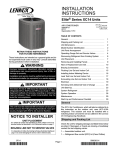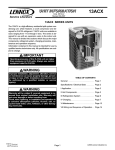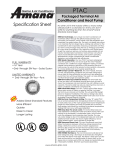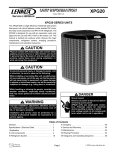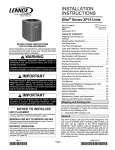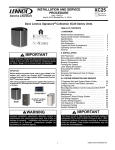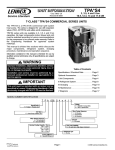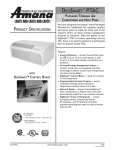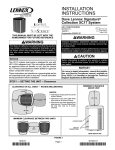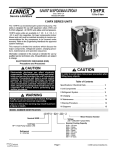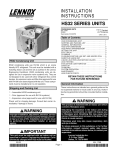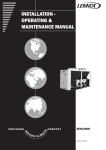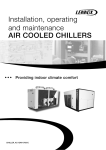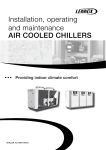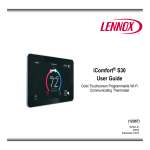Download WARNING CAUTION IMPORTANT IMPORTANT
Transcript
XC16 Corp. 0625−L5 Revised October 8, 2010 Service Literature XC16 (HFC−410A) SERIES UNITS WARNING Improper installation, adjustment, alteration, service or maintenance can cause personal injury, loss of life, or damage to property. Installation and service must be performed by a licensed professional installer (or equivalent) or a service agency. CAUTION Physical contact with metal edges and corners while applying excessive force or rapid motion can result in personal injury. Be aware of, and use caution when working near these areas during installation or while servicing this equipment. IMPORTANT TABLE OF CONTENTS Unit Dimensions . . . . . . . . . . . . . . . . . . . . . . . . . . . . . . . 4 Model Number Identification . . . . . . . . . . . . . . . . . . . . 2 Typical Serial Number Identification . . . . . . . . . . . . . . 2 Specifications . . . . . . . . . . . . . . . . . . . . . . . . . . . . . . . . . 2 Electrical Data . . . . . . . . . . . . . . . . . . . . . . . . . . . . . . . . 3 Unit Parts Arrangement . . . . . . . . . . . . . . . . . . . . . . . . 5 Operating Gauge Set and Service Valves . . . . . . . . . 6 Recovering Refrigerant from System . . . . . . . . . . . . . 8 Unit Placement . . . . . . . . . . . . . . . . . . . . . . . . . . . . . . . . 9 Removing and Installing Panels . . . . . . . . . . . . . . . . . 11 New or Replacement Line Set . . . . . . . . . . . . . . . . . . . 13 Brazing Connections . . . . . . . . . . . . . . . . . . . . . . . . . . . 15 Flushing Line Set and Indoor Coil . . . . . . . . . . . . . . . . 18 Installing Indoor Metering Device . . . . . . . . . . . . . . . . 19 Leak Test Line Set and Indoor Coil . . . . . . . . . . . . . . . 20 Evacuating Line Set and Indoor Coil . . . . . . . . . . . . . 21 Electrical . . . . . . . . . . . . . . . . . . . . . . . . . . . . . . . . . . . . . 22 Servicing Units Void of Charge . . . . . . . . . . . . . . . . . . 23 Unit Start−Up . . . . . . . . . . . . . . . . . . . . . . . . . . . . . . . . . . 23 System Refrigerant . . . . . . . . . . . . . . . . . . . . . . . . . . . . 23 System Operation . . . . . . . . . . . . . . . . . . . . . . . . . . . . . 28 Maintenance . . . . . . . . . . . . . . . . . . . . . . . . . . . . . . . . . . 28 Checklist . . . . . . . . . . . . . . . . . . . . . . . . . . . . . . . . . . . . . 31 Unit Wiring Diagram and Sequence of Operations . . . . . . . . . . . . . . . . . . . . . . . . . . . . . . . . . . . . 32 The XC16 Air Conditioners, which will also be referred to in this instruction as the outdoor unit, uses HFC−410A refrigerant. This outdoor unit must be installed with a matching indoor unit and line set as outlined in the Lennox XC16 Engineering Handbook. XC16 Air Conditioners are designed for use in thermal expansion valve (TXV) systems. NOTE The XC16 outdoor unit is rated for 230V applications only. A hard-start kit is required for applications where the supply voltage is less than 230V. IMPORTANT The Clean Air Act of 1990 bans the intentional venting of refrigerant (CFCs, HCFCs and HFCs) as of July 1, 1992. Approved methods of recovery, recycling or reclaiming must be followed. Fines and/or incarceration may be levied for noncompliance. This unit must be matched with an indoor coil as specified in Lennox XC16 Engineering Handbook. Coils previously charged with HCFC−22 must be flushed. Page 1 Model Number Identification X C 16 XXX 230 03 Refrigerant Type X = R−410A Minor Revision Number Voltage 230 = 208/230V−1ph−60hz Unit Type C = Air Conditioner Nominal Cooling Capacity 024 = 2 tons 036 = 3 tons 048 = 4 tons 060 = 5 tons Series Typical Serial Number Identification 19 09 C Location Code 19 = Saltillo, Mexico 58 = Marshalltown, IA 05716 5 (or 6) Digit Unique Number Year Code 08 = 2008 09 = 2009 10 = 2010 Month Code A = January B = February C = March Specifications Unit Model Number Outdoor Fan Sound Rating Number (dB)1 Factory Refrigerant Charge2 Number of Blades Diameter − inches. XC16−024−230−01 74 7 lbs. 5 oz. 3 18 XC16−024−230−02 74 7 lbs. 6 oz. 4 22 Unit Model Number Outdoor Fan Sound Rating Number (dB)1 Factory Refrigerant Charge2 Number of Blades Diameter − inches. XC16−036−230−01 76 8 lbs. 9 oz. 4 22 XC16−036−230−02 76 8 lbs. 9 oz. 4 22 XC16−036−230−03 76 8 lbs. 8 oz. 4 22 Unit Model Number Outdoor Fan Sound Rating Number (dB)1 Factory Refrigerant Charge2 Number of Blades Diameter − inches. XC16−048−230−01 76 11 lbs. 4 oz. 4 22 XC16−048−230−02 76 11 lbs. 4 oz. 4 22 Unit Model Number Outdoor Fan Sound Rating Number (dB)1 Factory Refrigerant Charge2 Number of Blades Diameter − inches. XC16−060−230−01 78 14 lbs. 2 oz. 3 26 XC16−060−230−02 78 14 lbs. 2 oz. 3 26 1 Tested according to AHRI Standard 270−2008 test conditions. 2 Refrigerant charge sufficient for 15 feet length of refrigerant lines. Page 2 Electrical Data 208/230V−60 Hz−1 Ph Unit Compressor Condenser Fan Maximum Over− current Protection (amps)1 Minimum Circuity Ampacity2 Rated Load Amps (RLA) Locked Rotor Amps (LRA) Motor HP Nominal RPM Full Load Amps (FLA) XC16−024−230−01 20 13.6 10.25 52.0 1/10 1075 0.7 1.4 XC16−024−230−02 20 13.6 10.25 52.0 1/6 825 1.1 1.87 Model Number Locked Rotor Amps (LRA) 208/230V−60 Hz−1 Ph Unit Compressor Condenser Fan Maximum Over− current Protection (amps)1 Minimum Circuity Ampacity2 Rated Load Amps (RLA) Locked Rotor Amps (LRA) Motor HP Nominal RPM Full Load Amps (FLA) XC16−036−230−01 35 22.0 16.67 82.0 1/6 825 1.1 2.1 XC16−036−230−02 35 22.0 16.67 82.0 1/6 825 1.1 1.87 XC16−036−230−03 35 22.0 16.67 82.0 1/10 825 1.1 1.87 Model Number Locked Rotor Amps (LRA) 208/230V−60 Hz−1 Ph Unit Compressor Condenser Fan Maximum Over− current Protection (amps)1 Minimum Circuity Ampacity2 Rated Load Amps (RLA) Locked Rotor Amps (LRA) Motor HP Nominal RPM Full Load Amps (FLA) Locked Rotor Amps (LRA) XC16−048−230−01 45 28.2 21.15 96.0 1/4 825 1.7 3.1 XC16−048−230−02 45 28.2 21.15 96.0 1/4 825 1.7 3.1 Model Number 208/230V−60 Hz−1 Ph Unit Compressor Condenser Fan Maximum Over− current Protection (amps)1 Minimum Circuity Ampacity2 Rated Load Amps (RLA) Locked Rotor Amps (LRA) Motor HP Nominal RPM Full Load Amps (FLA) Locked Rotor Amps (LRA) XC16−060−230−01 55 33.9 25.64 118.0 1/3 825 1.8 2.9 XC16−060−230−02 55 33.9 25.87 118.0 1/3 825 1.8 2.9 Model Number 1 HACR 2 Refer type circuit breaker or fuse. to National or Canadian Electrical Code manual to determine wire, fuse and disconnect size requirements. Page 3 XC16 SERIES Unit Dimensions − Inches (mm) LIQUID LINE CONNECTION C ELECTRICAL INLETS A SUCTION LINE CONNECTION 4−3/4" (121) 4−1/2" (108) B TOP VIEW SIDE VIEW UNIT SUPPORT FEET D K E J H G F XC14−024 TO −060 BASE WITH ELONGATED LEGS A B C XC16−024−230−01 35 (889) 27 (686) 28 (711) XC16−024−230−02 and later 39 (991) 30−1/2 (775) 35 (889) XC16−036−230−01 31 (787) 30−1/2 (775) 35 (889) XC16−036−230−03 and later 45 (1143) 30−1/2 (775) 35 (889) XC16−048−230−01 39 (991) 30−1/2 (775) 35 (889) XC16−060−230−01 and later 39 (991) 35−1/2 (902) 39−3/8 (1001) Model Number D E F G H J K 13−7/8 (352) 7−3/4 (197) 3−1/4 (83) 27−1/8 (689) 3−5/8 (92) 4−1/2 (114) 20−5/8 (524) 16−7/8 (429) 8−3/4 (222) 3−1/8 (79) 30−3/4 (781) 4−5/8 (117) 3−3/4 (95) 26−7/8 (683) Page 4 Typical Unit Parts Arrangement CONTROL PANEL CONTACTOR−1POLE (K1−1) GROUND LUG CAPACITOR (C12) COMPRESSOR COMPRESSOR HARNESS CRANKCASE THERMOSTAT (S40) −048 AND −060 UNITS ONLY HIGH PRESSURE SWITCH (MANUAL RESET) (S4) LIQUID LINE FILTER DRIER (SINGLE FLOW) LOW PRESSURE SWITCH (S87) SUCTION LINE SERVICE VALVE LIQUID LINE SERVICE VALVE FIELD CONNECTION FOR SUCTION LINE FIELD CONNECTION FOR LIQUID LINE SET PLUMBING, SWITCHES AND SENSOR COMPONENTS Figure 1. Typical Parts Arrangements Page 5 XC16 SERIES IMPORTANT WARNING Only use Allen wrenches of sufficient hardness (50Rc − Rockwell Harness Scale minimum). Fully insert the wrench into the valve stem recess. Service valve stems are factory−torqued (from 9 ft−lbs for small valves, to 25 ft−lbs for large valves) to prevent refrigerant loss during shipping and handling. Using an Allen wrench rated at less than 50Rc risks rounding or breaking off the wrench, or stripping the valve stem recess. See the Lennox Service and Application Notes #C−08−1 for further details and information. This product and/or the indoor unit it is matched with may contain fiberglass wool. Disturbing the insulation during installation, maintenance, or repair will expose you to fiberglass wool dust. Breathing this may cause lung cancer. (Fiberglass wool is known to the State of California to cause cancer.) Fiberglass wool may also cause respiratory, skin, and eye irritation. To reduce exposure to this substance or for further information, consult material safety data sheets available from address shown below, or contact your supervisor. IMPORTANT Lennox Industries Inc. P.O. Box 799900 Dallas, TX 75379−9900 To prevent stripping of the various caps used, the appropriately sized wrench should be used and fitted snugly over the cap before tightening. Table 1. Torque Requirements WARNING Electric Shock Hazard. Can cause injury or death. Unit must be grounded in accordance with national and local codes. Line voltage is present at all components when unit is not in operation on units with single-pole contactors. Disconnect all remote electric power supplies before opening access panel. Unit may have multiple power supplies. Parts Recommended Torque Service valve cap 8 ft.− lb. 11 NM Sheet metal screws 16 in.− lb. 2 NM Machine screws #10 28 in.− lb. 3 NM Compressor bolts 90 in.− lb. 10 NM Gauge port seal cap 8 ft.− lb. 11 NM USING MANIFOLD GAUGE SET When checking the system charge, only use a manifold gauge set that features low loss anti−blow back fittings. Operating Gauge Set and Service Valves These instructions are intended as a general guide and do not supersede local codes in any way. Consult authorities who have jurisdiction before installation. TORQUE REQUIREMENTS When servicing or repairing heating, ventilating, and air conditioning components, ensure the fasteners are appropriately tightened. Table 1 lists torque values for fasteners. Manifold gauge set used with HFC−410A refrigerant systems must be capable of handling the higher system operating pressures. The gauges should be rated for use with pressures of 0 − 800 psig on the high side and a low side of 30" vacuum to 250 psig with dampened speed to 500 psi. Gauge hoses must be rated for use at up to 800 psig of pressure with a 4000 psig burst rating. OPERATING SERVICE VALVES The liquid and vapor line service valves are used for removing refrigerant, flushing, leak testing, evacuating, checking charge and charging. Each valve is equipped with a service port which has a factory−installed valve stem. Figure 2 provides information on how to access and operating both angle and ball service valves. Page 6 SERVICE VALVES ANGLE AND BALL Operating Angle Type Service Valve: 1. Remove stem cap with an appropriately sized wrench. 2. Use a service wrench with a hex−head extension (3/16" for liquid line valve sizes and 5/16" for vapor line valve sizes) to back the stem out counterclockwise as far as it will go. SERVICE PORT CAP SERVICE PORT CORE TO INDOOR UNIT (VALVE STEM SHOWN CLOSED) INSERT HEX WRENCH HERE (VALVE STEM SHOWN OPEN) INSERT HEX WRENCH HERE SERVICE PORT CORE STEM CAP TO OUTDOOR UNIT ANGLE−TYPE SERVICE VALVE (FRONT−SEATED CLOSED) ANGLE−TYPE SERVICE VALVE (BACK−SEATED OPENED) When service valve is OPEN, the service port is open to linE set, indoor and outdoor unit. To Access Service Port: Operating Ball Type Service Valve: A service port cap protects the service port core from contamination and serves as the primary leak seal. 1. Remove stem cap with an appropriately sized wrench. 2. Use an appropriately sized wrenched to open. To open valve, roate stem counterclockwise 90°. To close rotate stem clockwise 90°. TO INDOOR UNIT TO OPEN ROTATE STEM COUNTERCLOCKWISE 90°. TO CLOSE ROTATE STEM CLOCKWISE 90°. 1. Remove service port cap with an appropriately sized wrench. 2. Connect gauge set to service port. 3. When testing is completed, replace service port cap and tighten as follows: BALL (SHOWN CLOSED) VALVE STEM With torque wrench: Finger tighten and torque cap per table 1. Without torque wrench: Finger tighten and use an appropriately sized wrench to turn an additional 1/6 turn clockwise. Reinstall Stem Cap: 1/6 TURN 11 12 10 9 8 7 6 1 5 2 3 4 Stem cap protects the valve stem from damage and serves as the primary seal. Replace the stem cap and tighten as follows: SERVICE PORT 1/12 TURN SERVICE PORT CORE SERVICE PORT CAP TO OUTDOOR UNIT WHEN SERVICE VALVE IS CLOSED, THE SERVICE PORT IS OPEN TO THE LINE SET AND INDOOR UNIT. STEM CAP With Torque Wrench: Finger tighten and then torque cap per table 1. Without Torque Wrench: Finger tighten and use an appropriately sized wrench to turn an additional 1/12 turn clockwise. 11 12 1 2 10 9 3 4 8 7 6 5 NOTE A label with specific torque requirements may be affixed to the stem cap. If the label is present, use the specified torque. Figure 2. Angle and Ball Service Valves Page 7 XC16 SERIES Recovering Refrigerant from System 1 2 CONNECT MANIFOLD GAUGE SET DISCONNECT POWER Disconnect all power to the existing outdoor unit at the disconnect switch or main fuse box/breaker panel. Connect a gauge set, clean recovery cylinder and a recovery machine to the service ports of the existing unit. Use the instructions provided with the recovery machine to make the connections. MAIN FUSE BOX/BREAKER PANEL MAIN FUSE BOX/BREAKER PANEL MANIFOLD GAUGES RECOVERY MACHINE DISCONNECT SWITCH LOW CLEAN RECOVERY CYLINDER 3 RECOVERING REFRIGERANT HIGH OUTDOOR UNIT Remove existing HCFC−22 refrigerant using one of the following procedures: IMPORTANT Some system configurations may contain higher than normal refrigerant charge due to either large internal coil volumes, and/or long line sets. METHOD 1: Us this method if the existing outdoor unit is not equipped with shut−off valves, or if the unit is not operational and you plan to use the existing HCFC−22 to flush the system. Remove all HCFC−22 refrigerant from the existing system. Check gauges after shutdown to confirm that the entire system is completely void of refrigerant. METHOD 2: Use this method if the existing outdoor unit is equipped with manual shut−off valves, and you plan to use new HCFC−22 refrigerant to flush the system. The following devices could prevent full system charge recovery into the outdoor unit: Outdoor unit’s high or low−pressure switches (if applicable) when tripped can cycle the compressor OFF. Compressor can stop pumping due to tripped internal pressure relief valve. Compressor has internal vacuum protection that is designed to unload the scrolls (compressor stops pumping) when the pressure ratio meets a certain value or when the suction pressure is as high as 20 psig. (Compressor suction pressures should never be allowed to go into a vacuum. Prolonged operation at low suction pressures will result in overheating of the scrolls and permanent damage to the scroll tips, drive bearings and internal seals.) Once the compressor can not pump down to a lower pressure due to one of the above system conditions, shut off the vapor valve. Turn OFF the main power to unit and use a recovery machine to recover any refrigerant left in the indoor coil and line set. Perform the following task: A Start the existing HCFC−22 system in the cooling mode and close the liquid line valve. B Use the compressor to pump as much of the existing HCFC−22 refrigerant into the outdoor unit until the outdoor system is full. Turn the outdoor unit main power OFF and use a recovery machine to remove the remaining refrigerant from the system. NOTE It may be necessary to bypass the low pressure switches (if equipped) to ensure complete refrigerant evacuation. C D When the low side system pressures reach 0 psig, close the vapor line valve. Check gauges after shutdown to confirm that the valves are not allowing refrigerant to flow back into the low side of the system. Figure 3. Refrigerant Recovery Page 8 CLEARANCE ON ALL SIDES INCHES (MILLIMETERS) 6 (152) ACCESS PANEL CONTROL PANEL ACCESS LOCATION 30 (762) 12 (305) NOTES: Clearance to one of the other three sides must be 36 inches (914mm). Clearance to one of the remaining two sides may be 12 inches (305mm) and the final side may be 6 inches (152mm). LINE SET CONNECTIONS 36 (914) MINIMUM CLEARANCE ABOVE UNIT 48 (1219) MINIMUM CLEARANCE BETWEEN TWO UNITS 24 (610) Figure 4. Installation Clearances In order to avoid injury, take proper precaution when lifting heavy objects. PLACING UNIT ON SLAB When installing unit at grade level, the top of the slab should be high enough above grade so that water from higher ground will not collect around the unit. The slab should have a slope tolerance as described in figure 5, detail B. NOTE If necessary for stability, anchor unit to slab as described in figure 5, detail D. See Unit Dimensions on page 3 for sizing mounting slab, platforms or supports. Refer to figure 4 for mandatory installation clearance requirements. ELEVATING THE UNIT Units are outfitted with elongated support feet as illustrated in figure 5, detail C. POSITIONING CONSIDERATIONS Consider the following when positioning the unit: If additional elevation is necessary, raise the unit by extending the height of the unit support feet. This may be achieved by using a 2 inch (50.8mm) Schedule 40 female threaded adapter. The specified coupling will fit snuggly into the recessed portion of the feet. Use additional 2 inch (50.8mm) Schedule 40 male threaded adaptors which can be threaded into the female threaded adaptors to make additional adjustments to the level of the unit. NOTE Keep the height of extenders short enough to ensure a sturdy installation. If it is necessary to extend further, consider a different type of field−fabricated framework that is sturdy enough for greater heights. Unit Placement CAUTION Some localities are adopting sound ordinances based on the unit’s sound level registered from the adjacent property, not from the installation property. Install the unit as far as possible from the property line. When possible, do not install the unit directly outside a window. Glass has a very high level of sound transmission. For proper placement of unit in relation to a window see the provided illustration in figure 5, detail A. Page 9 XC16 SERIES DETAIL A Outside Unit Placement Install unit away from windows. DETAIL B Slab Mounting at Ground Level Install unit level or, if on a slope, maintain slope tolerance of two (2) degrees (or two inches per five feet [50 mm per 1.5 m]) away from building structure. BUILDING STRUCTURE MOUNTING SLAB TWO 90° ELBOWS INSTALLED IN LINE SET WILL REDUCE LINE SET VIBRATION. DETAIL C Elevated Slab Mounting using Feet Extenders GROUND LEVEL STABILIZING UNIT ON UNEVEN SURFACES DETAIL D Slab Side Mounting #10 1/2" LONG SELF−DRILLING SHEET METAL SCREWS COIL STABILIZING BRACKET (18 GAUGE METAL 2" WIDTH; HEIGHT AS REQUIRED) BASE PAN #10 1−1/4" LONG HEX HD SCREW AND FLAT WASHER CORNER POST BASE Concrete slab use two plastic anchors (hole drill 1/4") Wood or plastic slab no plastic anchor (hole drill 1/8") DETAIL E Deck Top Mounting Stabilizing bracket (18 gauge metal 2" (50.8mm) width; height as required); bend to form right angle as exampled below. LEG DETAIL MINIMUM ONE PER SIDE 2" (50.8MM) SCH 40 FEMALE THREADED ADAPTER 2" (50.8MM) SCH 40 MALE THREADED ADAPTER SAME FASTENERS AS SLAB SIDE MOUNTING. Use additional 2" SCH 40 male threaded adapters which can be threaded into the female threaded adapters to make additional adjustments to the level of the unit. FOR EXTRA STABILITY One bracket per side (minimum). For extra stability, two brackets per side, two inches (51mm) from each corner. IMPORTANT To help stabilize an outdoor unit, some installations may require strapping the unit to the pad using brackets and anchors commonly available in the marketplace. Figure 5. Placement, Slab Mounting and Stabilizing Unit Page 10 STABILIZING UNIT ON UNEVEN SURFACES NOTICE IMPORTANT Unit Stabilizer Bracket Use (field−provided): Always use stabilizers when unit is raised above the factory height. (Elevated units could become unstable in gusty wind conditions). Stabilizers may be used on factory height units when mounted on unstable an uneven surface. With unit positioned at installation site, perform the following: Roof Damage! This system contains both refrigerant and oil. Some rubber roofing material may absorb oil and cause the rubber to swell when it comes into contact with oil. The rubber will then bubble and could cause leaks. Protect the roof surface to avoid exposure to refrigerant and oil during service and installation. Failure to follow this notice could result in damage to roof surface. Removing and Installing Panels IMPORTANT 1. Remove two side louvered panels to expose the unit base. Do not allow panels to hang on unit by top tab. Tab is for alignment and not designed to support weight of panel. 2. Install the brackets as illustrated in figure 5, detail D or E using conventional practices. IMPORTANT To help stabilize an outdoor unit, some installations may require strapping the unit to the pad using brackets and anchors commonly available in the marketplace. 3. Replace the panels after installation is complete. ROOF MOUNTING Install the unit a minimum of 6 inches (152 mm) above the roof surface to avoid ice build−up around the unit. Locate the unit above a load bearing wall or area of the roof that can adequately support the unit. Consult local codes for rooftop applications. If unit coil cannot be mounted away from prevailing winter winds, a wind barrier should be constructed. Size barrier at least the same height and width as outdoor unit. Mount barrier 24 inches (610 mm) from the sides of the unit in the direction of prevailing winds. WARNING To prevent personal injury, or damage to panels, unit or structure, be sure to observe the following: While installing or servicing this unit, carefully stow all removed panels out of the way, so that the panels will not cause injury to personnel, nor cause damage to objects or structures nearby, nor will the panels be subjected to damage (e.g., being bent or scratched). While handling or stowing the panels, consider any weather conditions, especially windy conditions, that may cause panels to be blown around and battered. Page 11 XC16 SERIES LOUVERED PANEL REMOVAL Remove the louvered panels as follows: 1. Remove two screws, allowing the panel to swing open slightly. 2. Hold the panel firmly throughout this procedure. Rotate bottom corner of panel away from hinged corner post until lower three tabs clear the slots as illustrated in detail B. 3. Move panel down until lip of upper tab clears the top slot in corner post as illustrated in detail A. IMPORTANT! DO NOT ALLOW PANELS TO HANG ON UNIT BY TOP TAB. TAB IS FOR ALIGNMENT AND NOT DESIGNED TO SUPPORT WEIGHT OF PANEL. PANEL SHOWN SLIGHTLY ROTATED TO ALLOW TOP TAB TO EXIT (OR ENTER) TOP SLOT FOR REMOVING (OR INSTALLING) PANEL. SCREW HOLES LIP LOUVERED PANEL INSTALLATION Position the panel almost parallel with the unit as illustrated in detail D with the screw side as close to the unit as possible. Then, in a continuous motion: 1. Slightly rotate and guide the lip of top tab inward as illustrated in detail A and C; then upward into the top slot of the hinge corner post. 2. Rotate panel to vertical to fully engage all tabs. 3. Holding the panel’s hinged side firmly in place, close the right−hand side of the panel, aligning the screw holes. 4. When panel is correctly positioned and aligned, insert the screws and tighten. DETAIL A DETAIL B ROTATE IN THIS DIRECTION; THEN DOWN TO REMOVE PANEL Detail C MAINTAIN MINIMUM PANEL ANGLE (AS CLOSE TO PARALLEL WITH THE UNIT AS POSSIBLE) WHILE INSTALLING PANEL. ANGLE MAY BE TOO EXTREME PREFERRED ANGLE FOR INSTALLATION Figure 6. Removing and Installing Panels Page 12 HOLD DOOR FIRMLY TO THE HINGED SIDE TO MAINTAIN FULLY−ENGAGED TABS New or Replacement Line Set REFRIGERANT LINE SET This section provides information on installation or replacement of existing line set. If new or replacement line set is not being installed then proceed to Brazing Connections on page 15. IMPORTANT Lennox highly recommends changing line set when converting the existing system from HCFC−22 to HFC−410A. If that is not possible and the line set is the proper size as reference in table 2, use the procedure outlined under Flushing the System on page 13. If refrigerant lines are routed through a wall, then seal and isolate the opening so vibration is not transmitted to the building. Pay close attention to line set isolation during installation of any HVAC system. When properly isolated from building structures (walls, ceilings. floors), the refrigerant lines will not create unnecessary vibration and subsequent sounds. See figure 7 for recommended installation practices. Also, consider the following when placing and installing a high−efficiency outdoor unit. Liquid lines that meter the refrigerant, such as RFC1 liquid lines, must not be used in this application. Existing line set of proper size as listed in table 2 may be reused. If system was previously charged with HCFC−22 refrigerant, then existing line set must be flushed (see Flushing the System on page 18). Field refrigerant piping consists of liquid and vapor lines from the outdoor unit to the indoor unit coil (braze connections). Use Lennox L15 (sweat, non−flare) series line set, or field−fabricated refrigerant line sizes as listed in table 2. Table 2. Refrigerant Line Set Inches (mm) Field Connections Model NOTE When installing refrigerant lines longer than 50 feet, see the Lennox Refrigerant Piping Design and Fabrication Guidelines, CORP. 9351−L9, or contact Lennox Technical Support Product Applications for assistance. To obtain the correct information from Lennox, be sure to communicate the following information: Model (XC16) and size of unit (e.g. −036). Line set diameters for the unit being installed as listed in table 2 and total length of installation. Number of elbows vertical rise or drop in the piping. The compressor is charged with sufficient Polyol ester oil for line set lengths up to 50 feet. Recommend adding oil to system based on the amount of refrigerant charge in the system. No need to add oil in system with 20 pounds of refrigerant or less. For systems over 20 pounds − add one ounce of every five pounds of refrigerant. Recommended topping−off POE oils are Mobil EAL ARCTIC 22 CC or ICI EMKARATE RL32CF. WARNING Polyol Ester (POE) oils used with HFC−410A refrigerant absorb moisture very quickly. It is very important that the refrigerant system be kept closed as much as possible. DO NOT remove line set caps or service valve stub caps until you are ready to make connections. IMPORTANT Mineral oils are not compatible with HFC−410A. If oil must be added, it must be a Polyol Ester oil. Recommended Line Set Liquid Line Suction Line Liquid Line Suction Line L15 Line Set −024 3/8". (10 mm) 3/4" (19 mm) 3/8" (10 mm) 3/4" (19 mm) L15−41 15 ft. − 50 ft. (4.6 m − 15 m) −036 −048 3/8". (10 mm) 7/8" (22 mm) 3/8" (10 mm) 7/8" (22 mm) L15−65 15 ft. − 50 ft. (4.6 m − 15 m) −060 3/8". (10 mm) 1−1/8". (29 mm) 3/8" (10 mm) 1−1/8" (29 mm) Field Fabricated Page 13 XC16 SERIES Line Set Isolation The following illustrations are examples of proper refrigerant line set isolation: REFRIGERANT LINE SET INSTALLING VERTICAL RUNS (NEW CONSTRUCTION SHOWN) REFRIGERANT LINE SET TRANSITION FROM VERTICAL TO HORIZONTAL ANCHORED HEAVY NYLON WIRE TIE OR AUTOMOTIVE MUFFLER-TYPE HANGER NOTE Insulate liquid line when it is routed through areas where the surrounding ambient temperature could become higher than the temperature of the liquid line or when pressure drop is equal to or greater than 20 psig. AUTOMOTIVE MUFFLER-TYPE HANGER OUTSIDE WALL LIQUID LINE VAPOR LINE WALL STUD WIRE TIE INSIDE WALL STRAP WOOD BLOCK BETWEEN STUDS STRAP LIQUID LINE TO VAPOR LINE NON−CORROSIVE METAL SLEEVE WIRE TIE LIQUID LINE NON−CORROSIVE METAL SLEEVE WOOD BLOCK VAPOR LINE − WRAPPED IN ARMAFLEX WIRE TIE STRAP REFRIGERANT LINE SET INSTALLING HORIZONTAL RUNS SLEEVE To hang line set from joist or rafter, use either metal strapping material or anchored heavy nylon wire ties. WIRE TIE (AROUND VAPOR LINE ONLY) VAPOR LINE WRAPPED WITH ARMAFLEX 8 FEET (2.43 METERS) STRAPPING MATERIAL (AROUND VAPOR LINE ONLY) OUTSIDE WALL FLOOR JOIST OR ROOF RAFTER LIQUID LINE TAPE OR WIRE TIE 8 FEET (2.43 METERS) PVC PIPE NON−CORROSIVE METAL SLEEVE TAPE OR WIRE TIE CAULK FIBERGLASS INSULATION STRAP THE VAPOR LINE TO THE JOIST OR RAFTER AT 8 FEET (2.43 METERS) INTERVALS THEN STRAP THE LIQUID LINE TO THE VAPOR LINE. NOTE Similar installation practices should be used if line set is to be installed on exterior of outside wall. FLOOR JOIST OR ROOF RAFTER Figure 7. Line Set Installation Page 14 Brazing Connections Use the procedures outline in figures 8 and 9 for brazing line set connections to service valves. WARNING Danger of fire. Bleeding the refrigerant charge from only the high side may result in pressurization of the low side shell and suction tubing. Application of a brazing torch to a pressurized system may result in ignition of the refrigerant and oil mixture − Check the high and low pressures before applying heat. IMPORTANT Connect gauge set low pressure side to vapor line service valve and repeat procedure starting at paragraph 4 for brazing the liquid line to service port valve. IMPORTANT Allow braze joint to cool before removing the wet rag from the service valve. Temperatures above 250ºF can damage valve seals. IMPORTANT WARNING When using a high pressure gas such as dry nitrogen to pressurize a refrigeration or air conditioning system, use a regulator that can control the pressure down to 1 or 2 psig (6.9 to 13.8 kPa). CAUTION Brazing alloys and flux contain materials which are hazardous to your health. Avoid breathing vapors or fumes from brazing operations. Perform operations only in well−ventilated areas. Wear gloves and protective goggles or face shield to protect against burns. Wash hands with soap and water after handling brazing alloys and flux. Use silver alloy brazing rods with 5% minimum silver alloy for copper−to−copper brazing. Use 45% minimum alloy for copper−to−brass and copper−to−steel brazing. WARNING Fire, Explosion and Personal Safety Hazard. Failure to follow this warning could result in damage, personal injury or death. Never use oxygen to pressurize or purge refrigeration lines. Oxygen, when exposed to a spark or open flame, can cause fire and/or an explosion, that could result in property damage, personal injury or death. Page 15 XC16 SERIES 1 CUT AND DEBUR Cut ends of the refrigerant lines square (free from nicks or dents) and debur the ends. The pipe must remain round. Do not crimp end of the line. 2 CAP AND CORE REMOVAL Remove service cap and core from both the suction / vapor and liquid line service ports. CUT AND DEBUR SERVICE PORT CAP SERVICE PORT CORE LINE SET SIZE MATCHES SERVICE VALVE CONNECTION SERVICE PORT CORE SERVICE VALVE CONNECTION SERVICE PORT CAP COPPER TUBE STUB LIQUID LINE SERVICE VALVE REDUCER LINE SET SIZE IS SMALLER THAN CONNECTION SUCTION / VAPOR LINE SERVICE VALVE DO NOT CRIMP SERVICE VALVE CONNECTOR WHEN PIPE IS SMALLER THAN CONNECTION REFRIGERANT LINE 3 ATTACH THE MANIFOLD GAUGE SET FOR BRAZING LIQUID AND SUCTION / VAPOR LINE SERVICE VALVES Flow regulated nitrogen (at 1 to 2 psig) through the low−side refrigeration gauge set into the liquid line service port valve, and out of the suction / vapor line service port valve. A Connect gauge set low pressure side to liquid line service valve (service port). USE REGULATOR TO FLOW B Connect gauge set center port to bottle of nitrogen with regulator. C Remove core from valve in suction / vapor line service port to allow nitrogen to escape. SUCTION / VAPOR SERVICE PORT MUST BE OPEN TO ALLOW EXIT POINT FOR NITROGEN C LOW HIGH NITROGEN AT 1 TO 2 PSIG. ATTACH GAUGES B SUCTION / VAPOR LINE SERVICE VALVE VAPOR LINE OUTDOOR UNIT INDOOR UNIT NITROGEN LIQUID LINE LIQUID LINE SERVICE VALVE A WHEN BRAZING LINE SET TO SERVICE VALVES, POINT FLAME AWAY FROM SERVICE VALVE. Figure 8. Brazing Procedures Page 16 4 5 6 WRAP SERVICE VALVES To help protect service valve seals during brazing, wrap water saturated cloths around service valve bodies and copper tube stubs. Use additional water saturated cloths underneath the valve body to protect the base paint. FLOW NITROGEN Flow regulated nitrogen (at 1 to 2 psig) through the refrigeration gauge set into the valve stem port connection on the liquid service valve and out of the suction / vapor valve stem port. See steps 3A, 3B and 3C on manifold gauge set connections BRAZE LINE SET Wrap both service valves with water saturated cloths as illustrated here and as mentioned in step 4, before brazing to line set. Water saturated cloths must remain water saturated throughout the brazing and cool−down process. LIQUID LINE SERVICE VALVE WHEN BRAZING LINE SET TO SERVICE VALVES, POINT FLAME AWAY FROM SERVICE VALVE. IMPORTANT Allow braze joint to cool. Apply additional water saturated cloths to help cool brazed joint. Do not remove water saturated cloths until piping has cooled. Temperatures above 250ºF will damage valve seals. WATER SATURATED CLOTH LIQUID LINE WARNING SUCTION / VAPOR LINE SERVICE VALVE 1. FIRE, PERSONAL INJURY, OR PROPERTY DAMAGE will result if you do not wrap a water saturated cloth around both liquid and suction line service valve bodies and copper tube stub while brazing in the line set! The braze, when complete, must be quenched with water to absorb any residual heat. 2. Do not open service valves until refrigerant lines and indoor coil have been leak−tested and evacuated. Refer to procedures provided in this supplement. WHEN BRAZING LINE SET TO SERVICE VALVES, POINT FLAME AWAY FROM SERVICE VALVE. SUCTION / VAPOR LINE WATER SATURATED CLOTH 7 PREPARATION FOR NEXT STEP After all connections have been brazed, disconnect manifold gauge set from service ports. Apply additional water saturated cloths to both services valves to cool piping. Once piping is cool, remove all water saturated cloths. Refer to the unit installation instructions for the next step in preparing the unit. Figure 9. Brazing Procedures (continued) Page 17 XC16 SERIES Flushing Line Set and Indoor Coil 1A TYPICAL EXISTING FIXED ORIFICE REMOVAL PROCEDURE (UNCASED COIL SHOWN) 1B TYPICAL EXISTING EXPANSION VALVE REMOVAL PROCEDURE (UNCASED COIL SHOWN) OR TWO PIECE PATCH PLATE (UNCASED COIL ONLY) DISTRIBUTOR TUBES LIQUID LINE ORIFICE HOUSING DISTRIBUTOR TUBES STUB END LIQUID LINE ORIFICE HOUSING CHECK EXPANSION VALVE TEFLON® RING TEFLON® RING FIXED ORIFICE BRASS NUT TEFLON® RING DISTRIBUTOR ASSEMBLY DISTRIBUTOR ASSEMBLY REMOVE AND DISCARD WHITE TEFLON® SEAL (IF PRESENT) A B C D E LIQUID LINE ASSEMBLY WITH BRASS NUT CONNECT GAUGES AND EQUIPMENT FOR FLUSHING PROCEDURE D E INVERTED HCFC−22 CYLINDER CONTAINS CLEAN HCFC−22 TO BE USED FOR FLUSHING. F A 1 GAUGE MANIFOLD LOW OPENED EXISTING INDOOR UNIT G H HIGH NEW OUTDOOR UNIT VAPOR LINE SERVICE VALVE CLOSED B TANK RETURN VAPOR LIQUID D C INLET DISCHARGE RECOVERY MACHINE A B C D MALE EQUALIZER LINE FITTING SENSING BULB Inverted HCFC−22 cylinder with clean refrigerant to the vapor service valve. HCFC−22 gauge set (low side) to the liquid line valve. HCFC−22 gauge set center port to inlet on the recovery machine with an empty recovery tank to the gauge set. Connect recovery tank to recovery machines per machine instructions. LIQUID LINE FLUSHING LINE SET The line set and indoor unit coil must be flushed with at least the same amount of clean refrigerant that previously charged the system. Check the charge in the flushing cylinder before proceeding. A Set the recovery machine for liquid recovery and start the recovery machine. Open the gauge set valves to allow the recovery machine to pull a vacuum on the existing system line B set and indoor unit coil. B Invert the cylinder of clean HCFC−22 and open its valve to allow liquid refrigerant to flow into the system through the vapor line valve. Allow the refrigerant to pass from the cylinder and through the line set and the indoor unit coil before it enters the recovery machine. C After all of the liquid refrigerant has been recovered, switch the recovery machine to vapor recovery so that all of the HCFC−22 vapor is recovered. Allow the recovery machine to pull down to 0 the system. D Close the valve on the inverted HCFC−22 drum and the gauge set valves. Pump the remaining refrigerant out of the recovery machine and turn the machine off. Figure 10. Installing Indoor Expansion Valve Page 18 VAPOR LINE On fully cased coils, remove the coil access and plumbing panels. Remove any shipping clamps holding the liquid line and distributor assembly. Disconnect the equalizer line from the check expansion valve equalizer line fitting on the vapor line. Remove the vapor line sensing bulb. Disconnect the liquid line from the check expansion valve at the liquid line assembly. Disconnect the check expansion valve from the liquid line orifice housing. Take care not to twist or damage distributor tubes during this process. Remove and discard check expansion valve and the two Teflon® rings. Use a field−provided fitting to temporary reconnect the liquid line to the indoor unit’s liquid line orifice housing. 3 LIQUID LINE SERVICE VALVE RECOVERY CYLINDER EQUALIZER LINE LIQUID LINE ASSEMBLY (INCLUDES STRAINER) On fully cased coils, remove the coil access and plumbing panels. Remove any shipping clamps holding the liquid line and distributor assembly. Using two wrenches, disconnect liquid line from liquid line orifice housing. Take care not to twist or damage distributor tubes during this process. Remove and discard fixed orifice, valve stem assembly if present and A Teflon® washer as illustrated above. B Use a field−provided fitting to temporary reconnect the liquid line to the indoor unit’s liquid line orifice housing. C 2 SENSING LINE Installing Indoor Metering Device This outdoor unit is designed for use in systems that use expansion valve metering devices at the indoor coil. See the Lennox XC16 Engineering Handbook for approved expansion valve kit match−ups. The expansion valve unit can be installed internal or external to the indoor INDOOR EXPANSION VALVE INSTALLATION TWO PIECE PATCH PLATE (UNCASED COIL ONLY) DISTRIBUTOR TUBES coil. In applications where an uncased coil is being installed in a field−provided plenum, install the expansion valve in a manner that will provide access for field servicing of the expansion valve. Refer to below illustration for reference during installation of expansion valve unit. A (Uncased Coil Shown) LIQUID LINE ORIFICE HOUSING STUB END B EXPANSION VALVE TEFLON® RING TEFLON® RING DISTRIBUTOR ASSEMBLY C D SENSING LINE E EQUALIZER LINE LIQUID LINE ASSEMBLY WITH BRASS NUT SENSING BULB INSTALLATION A MALE EQUALIZER LINE FITTING (SEE EQUALIZER LINE INSTALLATION FOR FURTHER DETAILS) VAPOR LINE LIQUID LINE Sensing bulb insulation is required if mounted external to the coil casing. sensing bulb installation for bulb positioning. B Attach the vapor line sensing bulb in the proper orientation as illustrated to the right using the clamp and screws provided. BULB FLARE NUT OR ON LINES SMALLER THAN 7/8", MOUNT SENSING BULB AT EITHER THE 3 OR 9 O’CLOCK POSITION. VAPOR LINE Remove and discard either the flare seal cap or flare nut with copper flare seal bonnet from the equalizer line port on the vapor line as illustrated in the figure to the right. Remove and discard either the flare seal cap or flare nut with copper flare seal bonnet from the equalizer line port on the vapor line as illustrated in the figure to the right. FLARE SEAL CAP 1/8 Turn NOTE Confirm proper thermal contact between vapor line 11 12 1 and expansion bulb before insulating the sensing bulb once 10 2 installed. 9 3 4 B Connect the equalizer line from the expansion valve to 8 7 6 5 the equalizer vapor port on the vapor line. Finger tighten the flare nut plus 1/8 turn (7 ft−lbs) as illustrated below. EQUALIZER LINE INSTALLATION A 1/2 Turn Remove the field−provided fitting that temporary reconnected the liquid line to the indoor unit’s distributor assembly. 11 12 1 2 Install one of the provided Teflon® rings around the 10 3 stubbed end of the expansion valve and lightly lubricate 9 4 the connector threads and expose surface of the Teflon® 8 7 5 6 ring with refrigerant oil. Attach the stubbed end of the expansion valve to the liquid line orifice housing. Finger tighten and use an appropriately sized wrench to turn an additional 1/2 turn clockwise as illustrated in the figure above, or 20 ft−lb. Place the remaining Teflon® washer around the other end of the expansion valve. Lightly lubricate connector threads and expose surface of the Teflon® ring with refrigerant oil. Attach the liquid line assembly to the expansion valve. Finger tighten and use an appropriately sized wrench to turn an additional 1/2 turn clockwise as illustrated in the figure above or 20 ft−lb. 12 BULB VAPOR LINE COPPER FLARE SEAL BONNET MALE BRASS EQUALIZER LINE FITTING 12 BULB ON 7/8" AND LARGER LINES, MOUNT SENSING BULB AT EITHER THE 4 OR 8 O’CLOCK POSITION. NEVER MOUNT ON BOTTOM OF LINE. BULB NOTE NEVER MOUNT ON BOTTOM OF LINE. VAPOR LINE Figure 11. Installing Indoor Expansion Valve Page 19 XC16 SERIES Leak Test Line Set and Indoor Coil IMPORTANT The Environmental Protection Agency (EPA) prohibits the intentional venting of HFC refrigerants during maintenance, service, repair and disposal of appliance. Approved methods of recovery, recycling or reclaiming must be followed. WARNING When using a high pressure gas such as dry nitrogen to pressurize a refrigeration or air conditioning system, use a regulator that can control the pressure down to 1 or 2 psig (6.9 to 13.8 kPa). IMPORTANT If this unit is being matched with an approved line set or indoor unit coil which was previously charged with mineral oil, or if it is being matched with a coil which was manufactured before January of 1999, the coil and line set must be flushed prior to installation. Take care to empty all existing traps. Polyol ester (POE) oils are used in Lennox units charged with HFC−410A refrigerant. Residual mineral oil can act as an insulator, preventing proper heat transfer. It can also clog the expansion device, and reduce the system performance and capacity. Failure to properly flush the system per the instructions below will void the warranty. 1 IMPORTANT Leak detector must be capable of sensing HFC refrigerant. WARNING Refrigerant can be harmful if it is inhaled. Refrigerant must be used and recovered responsibly. Failure to follow this warning may result in personal injury or death. CONNECT GAUGE SET A Connect an HFC−410A manifold gauge set high pressure hose to the vapor valve service port. LOW NOTE Normally, the high pressure hose is connected to the liquid line port. However, connecting it to the vapor port better protects the manifold gauge set from high pressure damage. With both manifold valves closed, connect the cylinder of HFC−410A refrigerant to the center port of the manifold gauge set. B NOTE Later in the procedure, the HFC−410A container will be replaced by the nitrogen container. HIGH MANIFOLD GAUGE SET OUTDOOR UNIT A B TO VAPOR SERVICE VALVE NITROGEN HFC−410A 2 TEST FOR LEAKS After the line set has been connected to the indoor and outdoor units, check the line set connections and indoor unit for leaks. Use the following procedure to test for leaks: A With both manifold valves closed, connect the cylinder of HFC−410A refrigerant to the center port of the manifold gauge set. Open the valve on the HFC−410A cylinder (vapor only). B Open the high pressure side of the manifold to allow HFC−410A into the line set and indoor unit. Weigh in a trace amount of HFC−410A. [A trace amount is a maximum of two ounces (57 g) refrigerant or three pounds (31 kPa) pressure]. Close the valve on the HFC−410A cylinder and the valve on the high pressure side of the manifold gauge set. Disconnect the HFC−410A cylinder. C Connect a cylinder of dry nitrogen with a pressure regulating valve to the center port of the manifold gauge set. D Adjust dry nitrogen pressure to 150 psig (1034 kPa). Open the valve on the high side of the manifold gauge set in order to pressurize the line set and the indoor unit. E After a few minutes, open one of the service valve ports and verify that the refrigerant added to the system earlier is measurable with a leak detector. F After leak testing disconnect gauges from service ports. Figure 12. Leak Test Page 20 Evacuating Line Set and Indoor Coil CONNECT GAUGE SET 1 NOTE Remove cores from service valves (if not already done). A Connect low side of manifold gauge set with 1/4 SAE in−line tee to vapor line service valve OUTDOOR B UNIT Connect high side of manifold gauge set to liquid line service valve A C Connect micron gauge available connector on the 1/4 SAE in−line tee. D Connect the vacuum pump (with vacuum gauge) to the center port of the NITROGEN manifold gauge set. The center port line will be used later for both the HFC−410A and nitrogen containers. HFC−410A LOW HIGH MANIFOLD GAUGE SET A34000 1/4 SAE TEE WITH SWIVEL COUPLER 500 MICRON GAUGE C TO VAPOR SERVICE VALVE B VACUUM PUMP TO LIQUID LINE SERVICE VALVE D 2 EVACUATE THE SYSTEM A B RECOMMEND MINIMUM 3/8" HOSE Open both manifold valves and start the vacuum pump. Evacuate the line set and indoor unit to an absolute pressure of 23,000 microns (29.01 inches of mercury). NOTE During the early stages of evacuation, it is desirable to close the manifold gauge valve at least once. A rapid rise in pressure indicates a relatively large leak. If this occurs, repeat the leak testing procedure. NOTE The term absolute pressure means the total actual pressure within a given volume or system, above the absolute zero of pressure. Absolute pressure in a vacuum is equal to atmospheric pressure minus vacuum pressure. C When the absolute pressure reaches 23,000 microns (29.01 inches of mercury), perform the following: D E F G Close manifold gauge valves Close valve on vacuum pump Turn off vacuum pump Disconnect manifold gauge center port hose from vacuum pump Attach manifold center port hose to a dry nitrogen cylinder with pressure regulator set to 150 psig (1034 kPa) and purge the hose. Open manifold gauge valves to break the vacuum in the line set and indoor unit. Close manifold gauge valves. Shut off the dry nitrogen cylinder and remove the manifold gauge hose from the cylinder. Open the manifold gauge valves to release the dry nitrogen from the line set and indoor unit. Reconnect the manifold gauge to the vacuum pump, turn the pump on, and continue to evacuate the line set and indoor unit until the absolute pressure does not rise above 500 microns (29.9 inches of mercury) within a 20−minute period after shutting off the vacuum pump and closing the manifold gauge valves. When the absolute pressure requirement above has been met, disconnect the manifold hose from the vacuum pump and connect it to an upright cylinder of HFC−410A refrigerant. Open the manifold gauge valve 1 to 2 psig in order to release the vacuum in the line set and indoor unit. Perform the following: 1/6 TURN Close manifold gauge valves. Shut off HFC−410A cylinder. Reinstall service valve cores by removing manifold hose from service valve. Quickly install cores with core tool while maintaining a positive system pressure. Replace stem caps and secure finger tight, then tighten an additional one−sixth (1/6) of a turn as illustrated. 11 10 9 8 12 1 2 4 7 6 3 5 Figure 13. Evacuating System Page 21 XC16 SERIES temperatures and pressures present during operation of an air conditioning system. Non−condensables and water suction combine with refrigerant to produce substances that corrode copper piping and compressor parts. IMPORTANT Use a thermocouple or thermistor electronic vacuum gauge that is calibrated in microns. Use an instrument capable of accurately measuring down to 50 microns. Electrical In the U.S.A., wiring must conform with current local codes and the current National Electric Code (NEC). In Canada, wiring must conform with current local codes and the current Canadian Electrical Code (CEC). Refer to the furnace or air handler installation instructions for additional wiring application diagrams and refer to unit nameplate for minimum circuit ampacity and maximum overcurrent protection size. 24VAC TRANSFORMER Use the transformer provided with the furnace or air handler for low-voltage control power (24VAC − 40 VA minimum) WARNING Danger of Equipment Damage. Avoid deep vacuum operation. Do not use compressors to evacuate a system. Extremely low vacuums can cause internal arcing and compressor failure. Damage caused by deep vacuum operation will void warranty. Evacuating the system of non−condensables is critical for proper operation of the unit. Non−condensables are defined as any gas that will not condense under SIZE CIRCUIT AND INSTALL DISCONNECT SWITCH 1 Refer to the unit nameplate for minimum circuit ampacity, and maximum fuse or circuit breaker (HACR per NEC). Install power wiring and properly sized disconnect switch. 2 MAIN FUSE BOX/BREAKER PANEL INSTALL THERMOSTAT Install room thermostat (ordered separately) on an inside wall approximately in the center of the conditioned area and 5 feet (1.5m) from the floor. It should not be installed on an outside wall or where it can be affected by sunlight or drafts. THERMOSTAT DISCONNECT SWITCH 5 FEET (1.5M) NOTE Units are approved for use only with copper conductors. Ground unit at disconnect switch or to an earth ground. HIGH VOLTAGE FIELD WIRING UNIT LOW VOLTAGE CONNECTIONS FACTORY WIRING LOW VOLTAGE (24V) FIELD WIRING WIRE NUTS WIRE RUN LENGTH AWG# INSULATION TYPE LESS THAN 100’ (30 METERS) 18 TEMPERATURE RATING MORE THAN 100’ (30 METERS) 16 35ºC MINIMUM. A B C YELLOW C BLACK 3 NOTE 24VAC, Class II circuit connections are made in the control panel. D Run 24VAC control wires through cutout with grommet. Run 24VAC control wires through wire tie. Make 24VAC control wire connections using field provided wire nuts. Tighten wire tie to security 24V control wiring. NOTE − FOR PROPER VOLTAGES, SELECT THERMOSTAT WIRE (CONTROL WIRES) GAUGE PER TABLE ABOVE. NOTE − WIRE TIE PROVIDES LOW VOLTAGE WIRE STRAIN RELIEF AND TO MAINTAIN SEPARATION OF FIELD INSTALLED LOW AND HIGH VOLTAGE CIRCUITS. A NOTE − DO NOT BUNDLE ANY EXCESS 24VAC CONTROL WIRES INSIDE CONTROL BOX. CUTOUT WITH GROMMET 24V CONTROL WIRES B D TIGHTEN WIRE TIE Page 22 2. Inspect all factory− and field−installed wiring for loose connections. Servicing Units Delivered Void of Charge If the outdoor unit is void of refrigerant, clean the system using the procedure described below. 1. Leak check system using procedure outlined on page 20. 2. Evacuate the system using procedure outlined on page 21. 3. Use nitrogen to break the vacuum and install a new filter drier in the system. 4. Evacuate the system again using procedure outlined on page 21. 5. Weigh in refrigerant using procedure outlined in figure 17. 6. Monitor the system to determine the amount of moisture remaining in the oil. It may be necessary to replace the filter drier several times to achieve the required dryness level. If system dryness is not verified, the compressor will fail in the future. Unit Start−Up IMPORTANT 3. After evacuation is complete, open both the liquid and vapor line service valves to release the refrigerant charge contained in outdoor unit into the system. 4. Replace the stem caps and tighten to the value listed in table 1. 5. Check voltage supply at the disconnect switch. The voltage must be within the range listed on the unit’s nameplate. If not, do not start the equipment until you have consulted with the power company and the voltage condition has been corrected. 6. Set the thermostat for a cooling demand. Turn on power to the indoor indoor unit and close the outdoor unit disconnect switch to start the unit. 7. Recheck voltage while the unit is running. Power must be within range shown on the nameplate. 8. Check system for sufficient refrigerant by using the procedures listed under System Charge. System Refrigerant If unit is equipped with a crankcase heater, it should be energized 24 hours before unit start−up to prevent compressor damage as a result of slugging. 1. Rotate fan to check for binding. This section outlines procedures for: 1. Connecting gauge set for testing and charging; 2. Checking and adjusting indoor airflow; 3. Adding or removing refrigerant. GAUGE SET MANIFOLD GAUGE SET HIGH LOW CONNECTIONS FOR TESTING AND CHARGING LINE B SUCTION SERVICE PORT CONNECTION OUTDOOR UNIT REFRIGERANT TANK CHARGE IN LIQUID PHASE A VAPOR LINE SERVICE VALVE DIGITAL SCALE D TEMPERATURE SENSOR C TO LIQUID LINE SERVICE VALVE TEMPERATURE SENSOR (LIQUID LINE) A Close manifold gauge set valves and connect the center hose to a cylinder of HFC−410A. Set for liquid phase charging. B Connect the manifold gauge set’s low pressure side to the suction line service port. C Connect the manifold gauge set’s high pressure side to the liquid line service port. D Position temperature sensor on liquid line near liquid line service port. LIQUID LINE SERVICE VALVE Figure 14. Gauge Set Setup and Connections Page 23 XC16 SERIES ADDING OR REMOVING REFRIGERANT This system uses HFC−410A refrigerant which operates at much higher pressures than HCFC−22. The pre−installed liquid line filter drier is approved for use with HFC−410A only. Do not replace it with components designed for use with HCFC−22. This unit is NOT approved for use with coils which use capillary tubes or fixed orifices as a refrigerant metering device. Check airflow using the Delta−T (DT) process using the illustration in figure 15. AIRFLOW INDOOR COIL Dry−bulb DT 80 24 24 24 23 23 22 22 22 20 19 18 17 16 15 78 23 23 23 22 22 21 21 20 19 18 17 16 15 14 76 22 22 22 21 21 20 19 19 18 17 16 15 14 13 74 21 21 21 20 19 19 18 17 16 16 15 14 13 12 72 20 20 19 18 17 17 16 15 15 14 13 12 11 10 70 19 19 18 18 17 17 16 15 15 14 13 12 11 10 Wet−bulb ºF 57 58 59 60 61 62 63 64 65 66 67 68 69 70 Temperature of air entering indoor coil ºF A B DRY BULB A 72º TDrop C 53º 19º air flow air flow B 64º DRY BULB INDOOR COIL All temperatures are expressed in ºF WET BULB Use the following procedure to adjust for optimal air flow across the indoor coil: 1. Determine the desired DT Measure entering air temperature using dry bulb (A) and wet bulb (B). DT is the intersecting value of A and B in the table (see triangle). 2. Find temperature drop across coil Measure the coil’s dry bulb entering and leaving air temperatures (A and C). Temperature Drop Formula: (TDrop) = A minus C. 3. Determine if fan needs adjustment If the difference between the measured TDrop and the desired DT (TDrop–DT) is within +3º, no adjustment is needed. See example below: Assume DT = 15 and A temp. = 72º, these C temperatures would necessitate stated actions: Cº TDrop – DT = ºF ACTION Changing air flow affects all temperatures; recheck 19 – 15 = 4 Increase the airflow temperatures to confirm that the temperature drop 58º 14 – 15 = −1 (within +3º range) no change and DT are within +3º. 62º 10 – 15 = −5 Decrease the airflow 4. Adjust the fan speed See indoor unit instructions to increase/decrease fan speed. 53º Figure 15. Checking Indoor Airflow over Evaporator Coil using Delta−T Chart Page 24 START: Determine how refrigerant is metered WHEN TO CHARGE? Warm weather best Can charge in colder weather TXV CHARGE METHOD? Determine by: Metering device type Outdoor ambient temperature OUTDOOR AMBIENT TEMPERATURE REQUIREMENTS: Sufficient heat load in structure Indoor temperature between 70-80ºF (21−26ºC) Manifold gauge set connected to unit Thermometers: − to measure outdoor ambient temperature − to measure liquid line temperature − to measure suction line temperature 65ºF (18.3ºC) and ABOVE APPROACH OR SUBCOOLING (SECOND STAGE − HIGH CAPACITY) 64ºF (17.7ºC) and BELOW WEIGH-IN Figure 16. Determining Charge Method WEIGH IN CHARGING METHOD 64ºF (17.7ºC) and Below CALCULATING SYSTEM CHARGE FOR OUTDOOR UNIT VOID OF CHARGE If the system is void of refrigerant, first, locate and repair any leaks and then weigh in the refrigerant charge into the unit. To calculate the total refrigerant charge: Amount specified on nameplate Adjust amount. for variation in line set length listed on line set length table below. Total charge + = Refrigerant Charge per Line Set Length Liquid Line Set Diameter Ounces per 5 feet (g per 1.5 m) adjust from 15 feet (4.6 m) line set* 3/8" (9.5 mm) 3 ounce per 5’ (85 g per 1.5 m) *If line length is greater than 15 ft. (4.6 m), add this amount. If line length is less than 15 ft. (4.6 m), subtract this amount. NOTE Insulate liquid line when it is routed through areas where the surrounding ambient temperature could become higher than the temperature of the liquid line or when pressure drop is equal to or greater than 20 psig. NOTE The above nameplate is for illustration purposes only. Go to actual nameplate on outdoor unit for charge information. Figure 17. Using HFC−410A Weigh In Method Page 25 XC16 SERIES START: Measure outdoor ambient temperature 1. Connect gauge set as illustrated in figure 14. 2. Confirm proper airflow across coil using figure 15. 3. Compare unit pressures with table 3, Normal Operating Pressures. 4. Set thermostat to call for heat (must have a cooling load between 70-80ºF (21−26ºC). 5. When heat demand is satisfied, set thermostat to call for cooling. 6. Allow temperatures and pressures to stabilize. 7. Record outdoor ambient temperature: AMBº =_________ 65ºF and ABOVE USE WEIGH-IN METHOD DO NOT CHARGE UNIT Weigh-in orof remove refrigerant (Results charging at low based upon line length temperatures not reliable) ABOVE or BELOW 64ºF and BELOW APPROACH TXV 8. Record liquid line temperature: LIQº = __________ If refrigerant is added or removed, retest to confirm that unit is properly charged. 9. Subtract to determine approach (APPº): LIQº_____ − AMBº _____ = APPº_____ 10. Compare results with table below. APPº (Approach) Values(F:+/−1.0° [C: +/−0.6°]) If value is greater than shown (high approach), add refrigerant; if less than shown (liquid temperature too close to ambient temperature, low approach), remove refrigerant. Models XC17−XXX−230−01 ºF (ºC)* −024 −036 −048 −060 Any 8 (4.4) 10 (5.6) 8 (4.4) 4 (2.2) *Temperature of air entering outdoor coil Models XC17−XXX−230−02/−03 ºF (ºC)* −024 −036 −048 −060 Any 6 (3.3) 6 (3.3) 8 (4.4) 4 (2.2) *Temperature of air entering outdoor coil Figure 18. Using HFC−410A Approach (TXV) Charge Method START: Measure outdoor ambient temperature USE METHOD DO WEIGH-IN NOT CHARGE UNIT Weigh-in or of remove refrigerant (Results charging at low based upon line length temperatures not reliable) C 65ºF and ABOVE ABOVE or BELOW 64ºF and BELOW SUBCOOLING TXV BLOCK OUTDOOR COIL: [sometimes necessary with lower temperatures] Use cardboard or plastic sheet to restrict the airflow through the outdoor coil to achieve pressures from 325−375 psig (2240−2585 kPa). Higher pressures are needed to check charge. Block equal sections of air intake panels and move coverings sideways until CARDBOARD OR the liquid pressure is in the above noted ranges. PLASTIC SHEETS If refrigerant is added or removed, verify charge using the Approach Method. If value is LESS than shown, add refrigerant. If value is MORE than shown, remove refrigerant. 1. Connect gauge set as illustrated in figure 14. 2. Confirm proper airflow across coil using figure 15. 3. Compare unit pressures with table 3, Normal Operating Pressures. 4. Set thermostat to call for heat (must have a cooling load between 70-80ºF (21−26ºC) 5. Measure outdoor ambient temperature 6. When heat demand is satisfied, set thermostat to call for cooling 7. Allow temperatures and pressures to stabilize. NOTE − If necessary, block outdoor coil to maintain 325 − 375 psig. 8. Record liquid line temperature: LIQº = ______ 9. Measure liquid line pressure and use the value to determine saturation temperature (see table 4): SATº = ______ 10. Subtract to determine subcooling (SCº): SATº_____ − LIQº _____ = SCº _____ 11. Compare results with table below. SCº (Subcooling) Values (F:+/−1.0° [C: +/−0.6°]) Models XC17−XXX−230−01 ºF (ºC)* −024 −036 −048 −060 Any 5 (2.8) 6 (3.3) 6 (3.3) 9 (5.0) *Temperature of air entering outdoor coil MORE or LESS Models XC17−XXX−230−02/−03 ºF (ºC)* −024 −036 −048 −060 Any 5 (2.8) 6 (3.3) 6 (3.3) 9 (5.0) *Temperature of air entering outdoor coil Figure 19. Using HFC−410A Subcooling (TXV) Charge Method Page 26 Table 3. Normal Operating Pressures (Liquid +10 and Suction +5 psig) Use this table to perform maintenance checks; it is not a procedure for charging the system. Minor variations in these pressures may be due to differences in installations. Significant deviations could mean that the system is not properly charged or that a problem exists with some component in the system. IMPORTANT XC16−XXX−230−01 5F (5C)* −024 Liquid −036 Suction Liquid −048 Suction Liquid −060 Suction Liquid Suction First Stage (Low Capacity) 65 (18.3) 223 141 227 137 224 142 215 136 75 (23.9) 256 143 261 142 258 144 250 139 85 (29.4) 297 145 302 145 299 146 291 142 95 (35.0) 341 148 347 148 345 148 337 144 105 (40.6) 389 150 396 150 395 150 388 146 115 (46.1) 443 153 452 154 450 153 444 148 65 (18.3) 232 140 244 132 235 135 220 130 75 (23.9) 268 143 278 139 269 137 256 133 85 (29.4) 310 145 321 142 313 139 299 136 95 (35.0) 356 147 368 144 361 141 347 138 105 (40.6) 405 149 419 147 412 143 402 141 115 (46.1) 459 152 476 150 471 146 462 143 Second Stage (High Capacity) XC16−XXX−230−02/−03 First Stage (Low Capacity) 65 (18.3) 215 144 226 142 224 142 215 136 75 (23.9) 247 146 261 144 258 144 250 139 85 (29.4) 288 148 304 145 299 146 291 142 95 (35.0) 332 151 352 147 345 148 337 144 105 (40.6) 381 153 405 150 395 150 388 146 115 (46.1) 435 155 460 150 450 153 444 148 65 (18.3) 225 140 228 144 235 135 220 130 75 (23.9) 258 142 262 146 269 137 256 133 85 (29.4) 301 144 306 148 313 139 299 136 95 (35.0) 346 146 353 150 361 141 347 138 105 (40.6) 397 149 405 151 412 143 402 141 115 (46.1) 452 151 462 154 471 146 462 143 Second Stage (High Capacity) *Temperature of air entering outdoor coil. Page 27 XC16 SERIES °F Psig °F Psig 32 33 34 35 36 37 38 39 40 41 42 43 44 45 46 100.8 102.9 105.0 107.1 109.2 111.4 113.6 115.8 118.0 120.3 122.6 125.0 127.3 129.7 132.2 48 49 50 51 52 53 54 55 56 57 58 59 60 61 62 137.1 139.6 142.2 144.8 147.4 150.1 152.8 155.5 158.2 161.0 163.9 166.7 169.6 172.6 175.4 47 134.6 Table 4. HFC−410A Temperature (°F) − Pressure (Psig) °F Psig °F Psig °F Psig °F Psig 63 64 65 66 67 68 69 70 71 72 73 74 75 76 77 178.5 181.6 184.3 187.7 190.9 194.1 197.3 200.6 203.9 207.2 210.6 214.0 217.4 220.9 224.4 78 228.0 79 80 81 82 83 84 85 86 87 88 89 90 91 92 93 231.6 235.3 239.0 242.7 246.5 250.3 254.1 258.0 262.0 266.0 270.0 274.1 278.2 282.3 286.5 System Operation The outdoor unit and indoor blower cycle on demand from the room thermostat. When the thermostat blower switch is in the ON position, the indoor blower operates continuously. HIGH PRESSURE SWITCH (S4) XC16 units are equipped with a high-pressure switch that is located in the liquid line of the compressor as illustrated in Unit Dimensions on page 4. The switch is a Single Pole, Single Throw (SPST), manual−reset switch with red cap that is normally closed and removes power from the compressor when discharge pressure rises above factory setting at 590 + 10 psi. LOW PRESSURE SWITCH (S87) XC16 units are also equipped with a low pressure switch that is located in the vapor line of the compressor. The switch (SPST, auto−reset, normally closed) removes power from the compressor when vapor line pressure drops below factory setting at 40 + 5 psi. 94 95 96 97 98 99 100 101 102 103 104 105 106 107 108 290.8 295.1 299.4 303.8 308.2 312.7 317.2 321.8 326.4 331.0 335.7 340.5 345.3 350.1 355.0 109 360.0 110 111 112 113 114 115 116 117 118 119 120 121 122 123 124 365.0 370.0 375.1 380.2 385.4 390.7 396.0 401.3 406.7 412.2 417.7 423.2 428.8 434.5 440.2 °F Psig °F Psig 125 126 127 128 129 130 131 132 133 134 135 136 137 138 139 445.9 451.8 457.6 463.5 469.5 475.6 481.6 487.8 494.0 500.2 506.5 512.9 519.3 525.8 532.4 141 142 143 144 145 146 147 148 149 150 151 152 153 154 155 545.6 552.3 559.1 565.9 572.8 579.8 586.8 593.8 601.0 608.1 615.4 622.7 630.1 637.5 645.0 140 539.0 TWO−STAGE COMPRESSOR The two−stage scroll compressor operates much like the standard scroll compressor. The two−stage compressor steps between low capacity and high capacity as required to meet cooling demand. The steps occur when gas is bypassed through a vent port in the first suction pocket. This bypassing of gas allows the compressor to operate at low capacity if thermostat demand allows, creating a more cost effective and efficient compressor. Full capacity is achieved by blocking the vent port with a slider ring. The slider ring (vent port cover) is controlled by a 24VDC internal solenoid in the open position allowing low capacity. When energized the internal solenoid closes the slider ring, blocking the vent port and bringing the compressor to full capacity. Stepping can occur during a single thermostat demand as the motor runs continuously while the compressor steps from low to full capacity. Maintenance DEALER Maintenance and service must be performed by a qualified installer or service agency. At the beginning of each cooling season, the system should be checked as follows: CRANKCASE THERMOSTAT (S40) (−048 AND −060 UNITS ONLY) Outdoor Unit 1. Clean and inspect the outdoor coil. The coil may be flushed with a water hose. Ensure the power is turned off before you clean the coil. 2. Outdoor fan motor is prelubricated and sealed. No further lubrication is needed. 3. Visually inspect connecting lines and coils for evidence of oil leaks. 4. Check wiring for loose connections. 5. Check for correct voltage at the unit (with the unit operating). 6. Check amp−draw outdoor fan motor. Compressor in the XC16−048 and −060 units are equipped with a 70 watt, belly band type crankcase heater. HR1 prevents liquid from accumulating in the compressor. HR1 is controlled by a thermostat located on the liquid line. When liquid line temperature drops below 50° F the thermostat closes energizing HR1. The thermostat will open, de−energizing HR1 once liquid line temperature reaches 70° F . FILTER DRIER A filter drier is factory-installed as illustrated in Unit Dimensions on page 4, with each XC16 unit to ensure a clean, moisture−free system. A replacement filter drier is available from Lennox. Refer to Lennox Repair Part Program. UNIT NAMEPLATE: _________ ACTUAL: __________ NOTE − If owner reports insufficient cooling, the unit should be gauged and refrigerant charge checked. Page 28 Outdoor Coil It may be necessary to flush the outdoor coil more frequently if it is exposed to substances which are corrosive or which block airflow across the coil (e.g., pet urine, cottonwood seeds, fertilizers, fluids that may contain high levels of corrosive chemicals such as salts) NOTE − Block outdoor coil to maintain a minimum of 375 psig during testing). 1. Turn main power OFF to outdoor unit. 2. Adjust room thermostat set point 5ºF above the room temperature. 3. Remove control access panel. Install refrigeration gauges on unit. Attach the amp meter to the common (black wire) wire of the compressor harness. Attach thermometer to discharge line as close as possible to the compressor. Outdoor Coil The outdoor coil may be flushed with a water hose. Outdoor Coil (Sea Coast) Moist air in ocean locations can carry salt, which is corrosive to most metal. Units that are located near the ocean require frequent inspections and maintenance. These inspections will determine the necessary need to wash the unit including the outdoor coil. Consult your installing contractor for proper intervals/procedures for your geographic area or service contract. INDOOR UNIT 1. Clean or change filters. 4. Turn toggle switch OFF and install switch in series with Y2 wire from room thermostat. 5. Cycle main power ON. 6. Allow pressures and temperatures to stabilize before taking measurements (may take up to 10 minutes). 7. Record all of the readings for the Y1 demand. 8. Close switch to energize Y2 demand. Verify power is going to compressor solenoid. 2. Adjust blower speed for cooling. Measure the pressure drop over the coil to determine the correct blower CFM. Refer to the unit information service manual for pressure drop tables and procedure. 9. Allow pressures and temperatures to stabilize before taking any measured reading (this may take up to 10 minutes). 3. Check blower drive belt for wear and proper tension. 10. Record all of the readings with the Y1 and Y2 demand. 4. Check all wiring for loose connections 5. Check for correct voltage at unit (blower operating). 6. Check amp−draw on blower motor. UNIT NAMEPLATE: _________ ACTUAL: __________ INDOOR COIL 1. Clean coil, if necessary. 11. If temperatures and pressures change in the direction noted in chart, the compressor is properly modulating from low to high capacity. (If no amperage, pressures or temperature readings change when this test is performed, the compressor is not modulating between low and high capacity and replacement is necessary). 12. After testing is complete, return unit to original set up. 2. Check connecting lines and coils for signs of oil leaks. HOMEOWNER 3. Check condensate line and clean, if necessary. Cleaning of the outdoor unit’s coil should be performed by a trained service technician. Contact your dealer and set up a schedule (preferably twice a year, but at least once a year) to inspect and service your outdoor unit. The following maintenance may be performed by the homeowner. TWO−STAGE COMPRESSOR CHECKS Use the checklist procedure on page 31, to verify part-load and full-load capacity operation of two-stage modulation compressors. IMPORTANT IMPORTANT This performance check is ONLY valid on systems that have clean indoor and outdoor coils, proper airflow over coils, and correct system refrigerant charge. All components in the system must be functioning proper to correctly perform compressor modulation operational check. (Accurate measurements are critical to this test as indoor system loading and outdoor ambient can affect variations between low and high capacity readings). Sprinklers and soaker hoses should not be installed where they could cause prolonged exposure to the outdoor unit by treated water. Prolonged exposure of the unit to treated water (i.e., sprinkler systems, soakers, waste water, etc.) will corrode the surface of steel and aluminum parts and diminish performance and longevity of the unit. Outdoor Coil Tools Required Refrigeration gauge set Digital volt/amp meter Electronic temperature thermometer On-off toggle switch The outdoor unit must be properly maintained to ensure its proper operation. Procedure Please contact your dealer to schedule proper inspection and maintenance for your equipment. Make sure no obstructions restrict airflow to the outdoor unit. Page 29 XC16 SERIES 4. Electronic Air Cleaner Some systems are equipped with an electronic air cleaner, designed to remove airborne particles from the air passing through the cleaner. If your system is so equipped, ask your dealer for maintenance instructions. 5. Indoor Unit The indoor unit’s evaporator coil is equipped with a drain pan to collect condensate formed as your system removes humidity from the inside air. Have your dealer show you the location of the drain line and how to check for obstructions. (This would also apply to an auxiliary drain, if installed.) Grass clippings, leaves, or shrubs crowding the unit can cause the unit to work harder and use more energy. Keep shrubbery trimmed away from the unit and periodically check for debris which collects around the unit. Cleaning of the outdoor unit’s coil should be performed by a trained service technician. Contact your dealer and set up a schedule (preferably twice a year, but at least once a year) to inspect and service your outdoor unit. Routine Maintenance Thermostat Operation In order to ensure peak performance, your system must be properly maintained. Clogged filters and blocked airflow prevent your unit from operating at its most efficient level. 1. Air Filter Ask your Lennox dealer to show you where your indoor unit’s filter is located. It will be either at the indoor unit (installed internal or external to the cabinet) or behind a return air grille in the wall or ceiling. Check the filter monthly and clean or replace it as needed. 2. Disposable Filter Disposable filters should be replaced with a filter of the same type and size. See the thermostat homeowner manual for instructions on how to operate your thermostat. NOTE If you are unsure about the filter required for your system, call your Lennox dealer for assistance. 3. Reusable Filter Many indoor units are equipped with reusable foam filters. Clean foam filters with a mild soap and water solution; rinse thoroughly; allow filter to dry completely before returning it to the unit or grille. NOTE The filter and all access panels must be in place any time the unit is in operation. Preservice Check If your system fails to operate, check the following before calling for service: Verify room thermostat settings are correct. Verify that all electrical disconnect switches are ON. Check for any blown fuses or tripped circuit breakers. Verify unit access panels are in place. Verify air filter is clean. If service is needed, locate and write down the unit model number and have it handy before calling. Accessories For update−to−date information, see any of the following publications: Page 30 Lennox XC16 Engineering Handbook Lennox Product Catalog Lennox Price Book Checklists Two−Stage Modulation Compressors Field Operational Checklist Unit Readings Expected results during Y2 demand (Toggle switch On) Y1 − First-Stage COMPRESSOR Voltage Amperage OUTDOOR UNIT FAN MOTOR Amperage TEMPERATURE Ambient Outdoor Coil Discharge Air Compressor Discharge Line Indoor Return Air Indoor Coil Discharge Air PRESSURES Suction (Vapor) Liquid Y2 − Second-Stage Same Higher Same or Higher Same Higher Higher Same Lower Lower Higher Start−Up and Performance Checklist Job Name Job no. Date Job Location City State Installer City State Unit Model No. Serial No. Service Technician Nameplate Voltage Rated Load Ampacity Compressor Outdoor Fan Maximum Fuse or Circuit Breaker Electrical Connections Tight? Indoor Filter clean? Supply Voltage (Unit Off) Indoor Blower RPM S.P. Drop Over Indoor (Dry) Outdoor Coil Entering Air Temp. Discharge Pressure Suction Pressure Refrigerant Charge Checked? Outdoor Fan Checked? Refrigerant Lines: Leak Checked? Properly Insulated? Service Valves: Fully Opened? Caps Tight? Thermostat Calibrated? Properly Set? Level? Voltage With Compressor Operating Page 31 XC16 SERIES Unit Wiring Diagram and Sequence of Operations Figure 20. XC16 Unit Wiring Diagram (All Builds) SEQUENCE OF OPERATIONS First and second stage cooling operate independent of each other and can modulate back and forth according to the thermostat demand. 3. K1 closes energizing B1 compressor and B4 outdoor fan. 4. Solenoid L34 is not energized so the slider ring remains open, limiting compressor to low capacity. First Stage Cooling (Low Capacity) Second Stage Cooling (Low Capacity) 1. Cooling demand imitates at Y1 at the thermostat. 2. Voltage from terminal Y passes through S4 high pressure switch, energizes K1 compressor contactor, passes through the low pressure switch (S87) and returns to common side of the 24VAC power. Compressor is operating in first stage cooling. Second stage thermostat demand sends voltage to rectifier plug D4. D4 converts the AC voltage to DC voltage and energizes L34 unloader solenoid. L34 closes the slider ring, allowing the compressor to operate at high capacity. Page 32
































